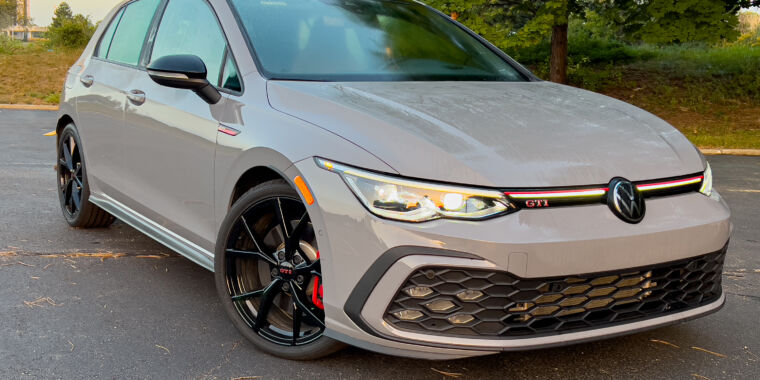
Jonathan Gitlin
“They don’t make ‘em like this for much longer” is a tired aphorism, but it certainly applies to the Volkswagen Golf GTI. The Mk 8 Golf is getting a midlife refresh next year, and when it does, VW will simplify things by ditching the manual transmission option. That means the 2024 model year will be the last chance to buy a three-pedal GTI. Yes, it has some flaws, but it’s also small and nimble, two qualities that are lacking in much of what the auto industry offers these days.
We’ve been a little remiss in not reviewing the Mk 8 Golf GTI so far. I reviewed the more expensive, more powerful Golf R in 2022 , but the last GTI we drove was the outgoing Mk 7 car in mid-2020. That time around, we could only find a GTI with the two-pedal, dual-clutch gearbox, a transmission that I felt wasn’t entirely suited to the engine it was mated to. Then again, I was quite enthusiastic about the old GTI’s infotainment, calling it “one of the best systems on the market”. Oh well, it was 2020, remember.
Under the hood, you’ll find another version of the VW Group’s venerable EA888 four-cylinder engine, here with a turbocharger and direct injection. It makes 241 hp (180 kW) and 273 lb-ft (370 Nm), with peak torque arriving at just 1,750 rpm. It sends power to the front wheels via a seven-speed DSG or the soon-to-be-retired six-speed manual transmission.
-
For this review we tested both the DSG and manual versions of the GTI.
Jonathan Gitlin
-
I don't know if the style of Golf is exactly the same from generation to generation as that of Star Trek movies, but I usually prefer the even numbers…
Jonathan Gitlin
-
VW decided to drop the three-door Golf when it introduced the Mk 8 Golf.
Jonathan Gitlin
-
There is 563 litres of luggage space with the seats in use, or 977 litres with the rear seats folded down.
Jonathan Gitlin
You can blame enlightened Europe for the six-speed's demise. There, buyers prefer the two-pedal version, which even the high acceptance rate for three-pedal GTIs in the US and Canada hasn't made up for. (This, of course, contradicts popular wisdom that all Europeans avoid cars as a matter of course.) What's more, VW decided that making the six-speed comply with the new Euro 7 emissions regulations was simply too much, so the company decided to drop the option.
Here in the US, both transmissions are rated at 27 mpg (8.7 L/100 km) combined, with the DSG doing better in city driving (24 mpg/9.8 L/100 km) and the manual doing slightly better on the highway (34 mpg/6.9 L/100 km). In real-world driving, I even saw 36 mpg (6.5 L/100 km) in highway driving with the three-pedal GTI.
A smarter GTI
A more modern electronic architecture was among the improvements made to the Golf from the Mk 7 to the Mk 8. On the plus side, it enables some clever vehicle dynamics control via the torque-sensing limited-slip differential, the GTI’s stability and traction control, and adaptive dampers, where fitted. Very enthusiastic drivers might prefer a mechanical limited-slip differential, but in everyday driving you’d never have a problem with the electronic version in the Mk 8 GTI.
The new electronics also marked a major technical upgrade for the interior. Gone are the physical analog gauges, replaced by a 10.25-inch digital display with several user-configurable views. A switch to capacitive control panels in place of discreet knobs adds an extra level of minimalism to VW’s traditionally spartan approach to cabin design, but they’re far too easy to activate accidentally.

